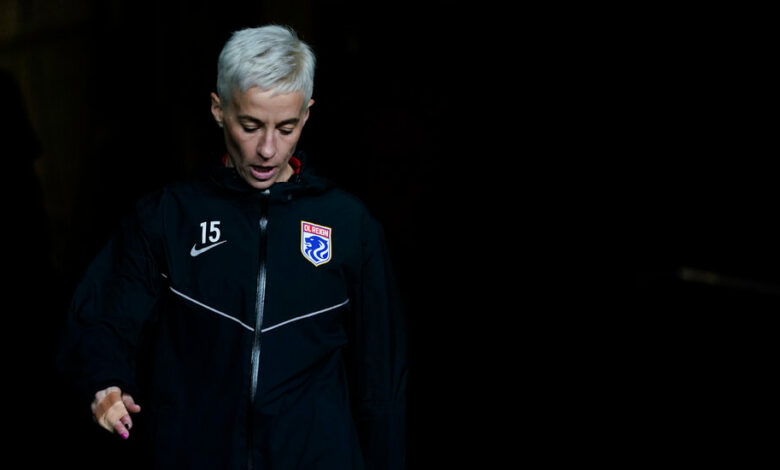Megan Rapinoe, Emma Hayes and a crossroads in women’s soccer

Emma Hayes first met Megan Rapinoe before she was Megan Rapinoe. Or, more accurately, when she was becoming Megan Rapinoe. She wasn’t yet a two-time World Cup winner, an Olympic gold medalist, the captain of her country, a forceful and urgent voice off the field. Rapinoe wasn’t even a professional soccer player yet, not quite yet.
Hayes’ job was to change that. In 2008, she was named head coach and director of soccer operations for the Chicago Red Stars, one of the first franchises in the start-up league Women’s Professional Soccer. Hayes had a blank slate to fill, a team to build from scratch. Rapinoe was her first call-up.
That may be the best measure of how brightly Rapinoe’s talent shone. When coach and player first met, Rapinoe was just 23 and a recent graduate of the University of Portland, but the power dynamic was already in her favor. She didn’t have to convince Hayes. Instead, Hayes had to convince her about the team, the project, the city.
So she showed Rapinoe, a California native, Chicago, hoping to convince her that the move to the shores of Lake Michigan would be her thing. It worked. The Red Stars drafted Rapinoe second overall ahead of the league’s inaugural season.
The WPS didn’t last long. It survived only three seasons. By the time it closed, Hayes had long since left the Red Stars. Rapinoe, however, was just getting started.
While Hayes was convinced of Rapinoe’s promise, even she wouldn’t pretend to know how far she’d go. This weekend, Rapinoe—now 38—will finally call it a day. Her plan is for her retirement to be marked by ticker tape and fireworks: one final triumph, helping OL Reign take down Gotham FC in the NWSL finals, a fittingly glorious conclusion to a brilliant career.
It’s no exaggeration to say that Rapinoe has been the defining player in women’s soccer for more than a decade. It’s not just that she was a key player in the United States’ 2015 World Cup triumph, and the driving force behind its repeat victory four years later. It’s that her activism, her unwillingness to shut up and play, transformed the U.S. women’s national team into something that transcended the sport. As a result, she helped set the tone for women’s soccer as a whole.
It’s fitting that Rapinoe’s farewell announcement comes just as Hayes, the woman who did so much to launch her career, is returning to the United States. Not officially, of course; at this point, the fact that Hayes will be the next coach of the U.S. women’s national team is little more than an open secret, a fait accompli that must—for now—be wrapped in a warm blanket of euphemism.
Anonymous sources will not go further than to say that Hayes and US Soccer “in conversation.” Chelsea, the club Hayes has coached with great success over the past decade, will only say that the 47-year-old coach will leave at the end of the current season to “to pursue a new opportunity” outside of the English Women’s Super League and club play. What exactly that opportunity is is not being revealed. Sure, maybe she’ll coach the US. Or maybe she wants to be a firefighter. It’s anyone’s guess.
There is only one fact that is certain, even if it is by far the most striking. Hayes, winner of six WSL titles and five FA Cups and by far the most prominent manager in women’s football in England, has quit her job. She has told Chelsea she is leaving. That, more than anything, reveals how far these mysterious talks have progressed.
It’s easy to see why the prospect of coaching the United States appeals to Hayes. The team’s history is so rich that it remains the most prestigious job in women’s soccer. Since she’ll get salary parity with Gregg Berhalter, the coach of the U.S. men’s team, it will also be the most lucrative.
Hayes will have to earn that money, though. The last time she took a job in the United States, her job was to help kick-start an era. A decade and a half later, that’s in the job description again. But the context is very different. This time, for a beginning, Hayes must oversee an ending.
It’s vaguely possible to view Hayes’ hiring as a throwback — her early-career resume includes stints with the Long Island Lady Riders (which we can all agree isn’t a great name for a team), the Washington Freedom and the Western New York Flash — but she wasn’t hired because of her familiarity with the modern landscape of American soccer. Rather, she was hired because she’s an outsider.
It’s not just that Hayes represents a significant break from tradition. Almost all of her predecessors as national coach came from positions on the Atlantic side that were slow to embrace contactless technology. The US job was, in a sense, the reward for success in American football.
It made perfect sense. For decades, the United States was the driving force behind women’s soccer. Professional competition, in whatever form, was the gold standard of the game. Players flocked there from all over the world, where domestic leagues were often professional in name only. The national team was the pinnacle of that program, and therefore the pinnacle of the game.
This summer, however, it became abundantly clear that things were changing. The United States were eliminated in the round of 16 of the World Cup. The impact on the tournament was minimal. What happened in Australia and New Zealand illustrated a power shift that had been brewing for some time. Two European teams were in the final. Five of the eight quarter-finalists were European.
Those countries, including the U.S., that pulled large portions of their teams from the NWSL often fell early. It was something Hayes herself had noticed. “There’s still a tremendous amount of talent on this American team,” she wrote in a column for The Daily Telegraph during the World Cup“But because so many players on the roster only play in the NWSL, there isn’t enough diversity on the roster when it comes to playing against different styles of play.”
She would be “shocked,” she wrote, if young players continued to migrate to the U.S. to play in the college system while professional teams recruited — and paid so well — in Europe. In the future, she predicted, it would be “very, very difficult” for the U.S. to regain its preeminence without “the right conversations about their model.”
That Hayes will lead those talks is, of course, a tacit admission that her assertion was correct. By appointing someone who has built his career and reputation in Europe to overturn the reality that it has fallen behind, US Soccer is essentially accepting the truth of it. One era is over, and it is time for another.
Perhaps this weekend’s NWSL finals are best viewed as a moment of transition. Rapinoe has never won an NWSL title. This is her last chance to end her wait, complete her set, put a golden bow on her career and all she has accomplished and represented.
That she would experience that moment playing for OL Reign, a team that was eventually controlled, by owners in France — would also be fitting, a nod not only to where the game came from, but also to where it’s going.
Correspondence
We were all too busy last week learning about the demographic transformation of Spain in the 20th century. Ben Coles to delete the correspondence, but I wanted to come back to his note this week, especially since the topic he raised is one I’ve been thinking about for a while. In a way. From the opposite perspective, in fact.
“Does every team from Everton and above in the current Premier League table have a little room for complacency this season?” Ben asked, in direct contradiction to the mantra that everything is necessarily the best in the best of all possible leagues. “Not because they’ve cracked the code of survival, but because Sheffield United, Burnley, Luton and Bournemouth are so bad? It almost feels like a non-league.”
I think it is fair to say that the dimensions of the relegation battle were drawn unusually early in the Premier League this season. Sheffield United had to be rebuilt in a flash. Burnley and Bournemouth both deployed a great deal – some would say excessively – of young and unproven talent. Luton made no attempt to hide the fact that they had no intention of wasting all the money they earned from promotion to the Premier League on the Sisyphean task of staying there.
That’s not to say that relegation is a foregone conclusion for any of them. Things change, and change quickly, at the start of the season. It’s hardly inconceivable that Fulham or Everton or Crystal Palace could have fallen into a slump within a few weeks, or that one of those teams currently doomed to a season of trouble has found some form. Luton in particular seem to be coming to terms with the demands of Premier League football at a rapid pace, as their (more than deserved) draw with Liverpool last week illustrated.
But there is one element working against those four clubs, and that is the quality at the other end of the Premier League table this season. Even taking into account that Manchester City are likely to win a fourth successive title, the group of teams immediately below them is unusually large.
There are eight clubs – Tottenham, Arsenal, Liverpool, Aston Villa, Newcastle, Brighton, Manchester United and Chelsea – who have legitimate ambitions of qualifying not just for Europe but also for the Champions League, with England likely to have five representatives in the revamped competition next season.
The overall quality of the competition may be higher than ever. That claim will of course be dismissed as review bias, or deliberate exaggeration, or simply deeply ahistorical; such is the power of nostalgia that governs our relationship with sport.
There is a strong tendency to assume that what came before was somehow better. After all, we tend to simultaneously remember the good things of the past (look at that Thierry Henry goal!) and only see the mistakes (Manchester City 6, Bournemouth 1) of the present.
But it increasingly feels as though the Premier League is starting to live up to not just the bombast of its own marketing material, but to its fundamental premise: for the first time, a majority of its clubs have found a way to use the vast amounts of cash at their disposal to become really, really good at football. That’s good for the clubs, and good for the fans, and good for the league. It’s not so good for the teams who are thrown in with little preparation.




